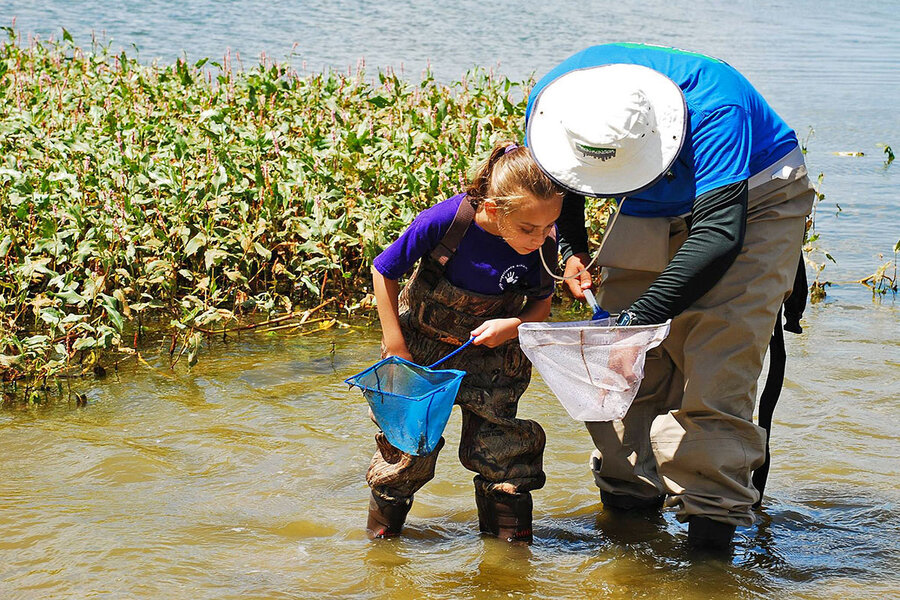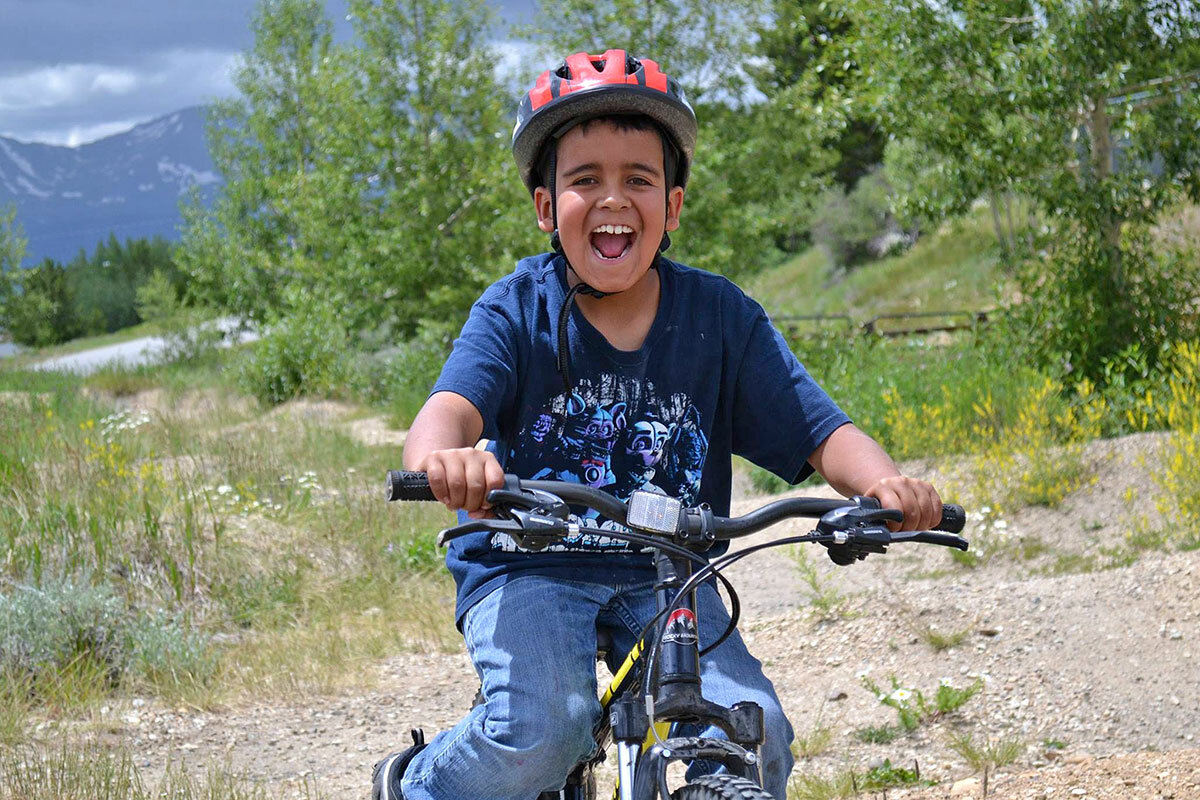Whose nature? Colorado leads push to democratize the outdoors.
Loading...
| Denver
For Amadeo Franco, a high school junior who lives in Denver’s Cole neighborhood, the chance to escape the city and spend days and weeks exploring the mountains and parks in Colorado and Utah has been a godsend.
Spending time in nature “is the only time I feel at peace in any sense of the phrase,” says Amadeo, who has been a regular participant in cityWILD, a free program that gets Denver kids out hiking, camping, rafting, and rock climbing, since he was in sixth grade. “I’ve developed friends who are now like my family,” he adds.
In theory, public spaces belong to everyone. But in reality, many low-income and minority children grow up feeling like nature is not a place for them. Colorado is on the forefront of a movement to lift barriers to nature and to help all children experience the peace that comes from spending time outdoors.
CityWILD has been actively working in Denver for 20 years, but it’s also a participant in a groundbreaking new effort taking place in 15 communities in Colorado. The goal is to increase access and connection to nature for under-served children and their families in a meaningful way: preschool to high school, backyard to backcountry.
“All children deserve nature and the outdoors. It’s a right, like clean air or clean water,” says Lise Aangeenbrug, who helped develop the $29 million Inspire Initiative when she was director of Great Outdoors Colorado (GOCO), a lottery-funded organization that has provided most of the funding. She cites numerous studies that link a connection with nature to physical and mental health, academics, civic engagement, and quality of life. “And if you’re from an organization that cares about conservation, you have to care about this. These kids are tomorrow’s voters, and conservation is only as permanent as tomorrow’s vote.”
The nature deficit
While Colorado’s program is perhaps the largest and most ambitious program to tackle the growing disconnect between children and nature, the issue of “nature deficit disorder” – a term that grew out of Richard Louv’s seminal 2005 book “Last Child in the Woods” – has been getting increased attention around the country. Last year, the state of Washington allocated $1.5 million for “No Child Left Inside” grants. And in 2016, Oregon voters approved a measure that dedicates $22 million in lottery funds each year to enable every fifth- and sixth-grader in the state to attend a week of immersive outdoor learning.
For some time, there’s been a growing recognition – bolstered by numerous studies – that spending time outdoors and in nature is important, and is losing out to electronic devices and organized activities for children from all walks of life, says Sarah Milligan-Toffler, director of the Children & Nature Network. But she says that it’s been harder to raise awareness about the systemic issues and barriers that create that disconnect, especially for many low-income and minority communities.
“If you’re going to have a conversation about this as important to all children, then you also have to talk about, are all children starting from same starting point,” says Ms. Milligan-Toffler.
In Colorado, that equity piece has been central to the Inspire Initiative, though a broader, statewide “Generation Wild” campaign that GOCO launched last year also hopes to encourage families all over the state to get outside. Ms. Aangeenbrug says that when she first broached this idea, she encountered skepticism. Colorado, after all, has an abundance of public lands, state and national parks, and green space where people can hike, fish, camp, and get outside. But a series of surveys and discussions in communities around the state revealed that wasn’t the case for everyone.
In Lamar, a small town in southeast Colorado, a state park is just 30 minutes away, but none of the students surveyed had ever been to it. Talking to students and families in urban, rural, and suburban communities, GOCO staff identified numerous barriers to getting outside, ranging from lack of time, knowledge, or the right gear, to simply not feeling welcome or not feeling like the outdoors were for people like them.
GOCO asked communities to submit proposals, with only a few requirements: they had to involve a trusted local partner; they had to involve youth leadership; and they had to include outdoor spaces close to home that were safe to access. The emphasis was to be on collaboration and development of meaningful connections to nature for families, young kids, and older kids, with programming both close to home and farther away. Beyond that, communities were encouraged to talk to and listen to the needs of residents, and come up with whatever model fit best. GOCO then provided an initial round of planning grants to help those communities further refine their ideas.
“For the longest time, it’s been dictated to certain communities what’s best for them,” says Jackie Miller, GOCO’s director of youth initiatives. “We wanted to authentically understand where the barriers are and come up with community-identified solutions.”
Leadville, Colo., was one of the first six communities to win funding. The highest incorporated city in the United States at over 10,000 feet, Leadville is surrounded by majestic 14,000-foot peaks, mountain lakes, and wilderness.
“Theoretically, there’s this rich environment where everyone has access, but the reality is that’s not the case,” says Beth Helmke, the director of Get Outdoors Leadville!, noting that Leadville’s student population is about 70 percent Latino and 60 percent qualify for free or reduced lunch. The GOCO grant allowed the town to create a web of programming that includes summer camps, a gear library, adventure days at a nearby ski area, and outdoor and hands-on learning through the local schools. They’ve partnered with Colorado Mountain College to create internships and dual-credit courses for high schoolers and expose them to possible career paths. And they have worked to make sure that information – from interpreter signs at recreation areas to paperwork for getting a fishing license – is available in Spanish as well as English.
“Creating the space to have honest conversations around this really brought to light some of those intangible barriers,” says Ms. Helmke.
'Pushed out of the outdoors'
In Denver, cityWILD has been involved in two of the Inspire Initiative communities, leading the programming for middle- and high-school aged kids with after-school clubs and nature excursions that range from short hiking or snow-shoeing excursions to week-long trips to the mountains of Colorado and Utah, complete with rock climbing and river rafting. They’ve also partnered with a local group that takes teenagers out to local ski areas and teaches them skiing and snowboarding.
“My favorite thing to do is rafting and camping,” says Shia Brooks, a tall, enthusiastic senior who also helps run the after-school club cityWILD hosts, and who says she now has been certified as both a rafting and rock climbing guide.
On this chilly winter afternoon, Shia and others in the program are gathered in cityWILD’s big, warehouse-like space in the Cole neighborhood to build camp stoves out of soda cans – part of a month-long focus on “fuel” as it relates to the mind, body, and spirit. But they’re also eagerly talking about the upcoming camping trip they’ll be taking to the Arkansas River Valley in March.
Jes Ward, cityWILD’s executive director, says the work is important when it comes to building the next generation of environmental stewards – but that it’s also critical from an equity standpoint.
Many of the kids she works with, Ms. Ward notes, feel like “they’ve been pushed out of the outdoors.”
And she and others insist that opening the door outside for all children will pay off down the line. A growing body of research suggests that bridging the nature deficit can in turn help close academic gaps while improving both physical and mental health. What’s more, there’s a calming and healing aspect to being outside – whether in a backcountry wilderness or urban green space a few blocks away – that is increasingly important.
“The technology we have on the one hand is amazing, but it’s also very hard to disconnect from that and it creates a lot of tension and anxiety,” says Milligan-Toffler. “Time spent in natural spaces, away from those devices, creates an opportunity for us all to restore and be more human. One of the things we’re learning is that our senses are actually being dulled through lack of time spent in the natural world, and no parent wants their child to be less alive.”







